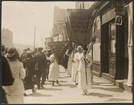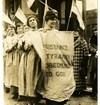These learning activities engage students with the history of women advocating for the right to vote. Each lesson uses an item from the National Woman's Party collection or an aspect of the story of suffrage to make connections to broad questions of working for change.
-
Article 1: Teaching Suffrage: Ida B. Wells in the Suffrage Procession

Have you ever wondered how to respond when you are told that you cannot do something? Have you seen someone else being excluded or left out? In this learning activity using the Suffrage in 60 Seconds video about Ida B. Wells, students discuss the experience of being excluded unfairly. What responsibility do we have to stand up and speak out when others are excluded or mistreated? Read more
-
Article 2: Teaching Suffrage: Protest

When is protest an effective tactic for change? Using two Suffrage in 60 Seconds videos about the National Woman's Party's campaign of picketing the White House, this lesson invites fourth grade students to discuss collective action. What strategies are most effective in convincing others to change their mind? Read more
-
Article 3: Teaching Suffrage: Symbols of Suffrage

Women in the suffrage movement had multiple items they wore that identified them as suffragists and supporters of the movement. Not only would they wear these items while they were protesting or picketing, but they would wear them to meetings and out in public settings. This activity designed for fifth grade students uses a historic photograph as a primary source to engage students in a discussion about how we communicate with what we wear. Read more
-
Article 4: Teaching Suffrage: Forward Into Light

How have signs and banners been used for change? In this learning activity designed for fifth grade, students examine a suffrage banner and compare it to signs used by other protest movements. They analyze how words and slogans have been used as strategies in the history of protest and imagine how they can take a stand in their everyday lives. Read more
-
Article 5: Teaching Suffrage: Arrested

How does identity shape our interactions with others? In this learning activity designed for fifth and sixth grade, students examine three photographs of women arrested for protesting for the right to vote. Through discussion, students will identify with different people from history and recognize that people may interact in complex ways. Read more
-
Article 6: Teaching Suffrage: Suffrage Prisoners Banner

Have you ever spoken out when you saw someone mistreated? This learning activity designed for fifth graders uses a photograph of Mary Winsor protesting against the imprisonment of suffrage protesters to spark discussion about the responsibility to speak out when you believe something is wrong and needs to change. Read more
-
Article 7: Teaching Suffrage: The Prison Special and the Courage to Speak Out

When have you needed courage? In this learning activity for fifth grade, students explore questions about when and how to take a stand in their everyday lives. Using photographs of Lucy Burns, co-founder of the National Woman's Party and the woman who spent more time in prison than any other American suffragist, students engage with questions about the courage needed to speak out. Read more
-
Article 8: Teaching Suffrage: Suffrage Cartoons

How can art be used to change people's minds? What happens when we leave someone out of the picture? In this learning activity, students evaluate the political cartoons of suffragist Nina Allender to discover how women are represented in her art, and who is left out. Then they will create their own artwork to build understanding, respect, and connection. Read more
-
Article 9: Teaching Suffrage: Anti-Suffrage Postcards

How have you responded when you have been teased or ridiculed? In this learning activity designed for sixth-eighth grade, students will examine four anti-suffrage postcards from the early 20th century and analyze how women and men are represented. They will make connections with the way people may be characterized today while learning to exchange ideas and beliefs in an open-minded way. Read more
-
Article 10: Teaching Suffrage: She's Good Enough

How can popular culture be used to advocate for change? In this learning activity for sixth-eighth grade, students examine a suffrage illustration modeled on a popular cartoon circulated during Teddy Roosevelt's re-election campaign. They will analyze the use of cultural touchstones to change public perception about an issue and evaluate when they have been influenced by popular culture. Read more
-
Article 11: Teaching Suffrage: Six Reasons for Suffrage

What actions should you take when believe something needs to change? In this learning activity designed for sixth-eighth grades, students examine a flier created by the National American Woman Suffrage Association that lists six reasons that women should be enfranchised across the country by amending the U.S. Constitution. They will analyze the arguments presented by the suffragists. Extend the lesson by creating your own flier. Read more
-
Article 12: Teaching Suffrage: Frenemies

How do we resolve conflict? What happens when those working for change agree on the goal but not the methods? In this learning activity for 9th-12th grade, students examine tensions in the suffrage movement using essays and a video about the topic. Using what they learn, they will develop conflict resolution strategies. Read more
